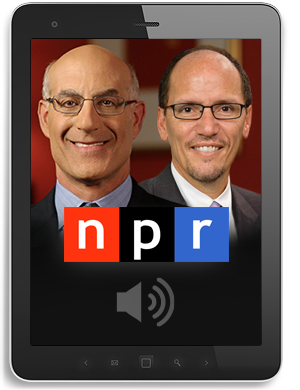Hidden Mutual Fund Fees That Are Robbing Your Returns

Mitch Tuchman speaks with U.S. News about how 1% mutual fund fees can actually add up to much more.
So you’ve accumulated a nest egg by investing in mutual funds. Congratulations! That puts you ahead of the game.
But to grow an even bigger stash, try squeezing out the fees.
“Make sure you pay as little of that gross return in fees as you can,” says Mitch Tuchman, Managing Director at Rebalance, a financial services company in Palo Alto, California. Fees ultimately eat into any gains made by the mutual funds you own.
But mutual fund fees are only about 1 percent of the assets, right? Wrong – on three counts.
Mutual funds can be expensive. The average mutual fund annual expenses for equity funds was 1.33 percent in 2014, according to the latest data available from the Investment Company Institute that tracks these things. That 1.33 percent is equivalent to $133 dollars per year for each $10,000 invested.
Bond funds’ annual expenses averaged 0.99 percent a year, or $99 per $10,000.
For someone with a heavy stock allocation, which most young people should favor, the annual expenses for the entire portfolio will average more than a percentage point.
Fees cut into your returns. Annual fees of only $1 out of $100 may sound puny, but they’re not. The broad stock market, such as the Standard & Poor’s 500 index, can be expected to grow by 6 to 8 percent a year, Tuchman says.
If you give away 1 percent of that return, you reduce the return by one sixth to one eighth. It’s worse for bond funds, where returns are likely to be more like 2 to 3 percent. In that case, you’d be reducing your gains by up to half, each and every year.
Know the different types of fees. The fees you may possibly pay are not solely the annual expenses. There are plenty more which can crush your portfolio returns.
Sales loads are a percentage of the money that is charged before it is even put to work. For instance, a 5 percent sales load, which is common for stock funds with such fees, would reduce a $10,000 investment to $9,500 immediately. You’d already be down $500 on day one!
Some people may pay a smaller load if they are investing a large dollar amount. Still, lower isn’t zero, which is the best size of any fee.
“There is no research showing load funds perform better than no-load funds,” says Bob Stammers, director of investor education at the CFA Institute. “You want to avoid the sales load.”
Instead, look for so-called “no-load funds,” of which there are many.
Sometimes the load charge happens when you cash in your investment rather than at the very beginning. Again, it’s something you want to avoid, so read the fine print.
Short-term trading fees get charged when investors sell a mutual fund after holding it for less than a certain period. That length of the period when you’d pay the fee can be as little as 30 days, but such stipulations vary. Investors may see a note by a fund which states a 1 percent charge on sales of shares held less than 60 days, for example.
“The idea is to discourage short-term trading,” Stammers says. Most retail investors simply do not have the skill to profitably time the market.
If you think there is a chance that you might want to bolt from a fund quickly, then avoid funds with such provisions.
A 12b1 fee can be confusing to investors, partly because not every fund has it. The fee is disclosed in the fund prospectus and is used for marketing or distribution costs. It can vary from 0.25 percent and 1 percent.
But you don’t have to add that to the annual expenses because they are already included in that total, says Russ Kinnel, director of manager research at Morningstar.
Look at the overall expense. The good news is that many investors are catching on to the idea that fees should be avoided as much as possible. For some though, the big psychological problem is that in much of life you get what you pay for.
For instance, a prime porterhouse steak at a restaurant is going to cost a lot more than a hot dog from a street vendor, but many would say the price difference is worth it. But for investors, the less you pay, the more you get. “Generally with investing it goes the other way around,” Kinnel says.
The trick is to find funds with low overall expenses, such as index funds. Many fund companies make such offerings, two of the biggest are Vanguard and Fidelity Investments.
One fund is the Vanguard 500 Index Admiral fund (ticker: VFIAX), which has annual expenses of 0.05 percent, or $5 a year per $10,000 invested.
Likewise, Fidelity Investments has the Fidelity Spartan 500 Index (FUSEX) fund, which has annual expenses of 0.1 percent.
There are low-cost funds that do not simply track an index, but it’s worth noting that much research has shown that few if any funds can manage to beat their benchmark indices over the long term.






